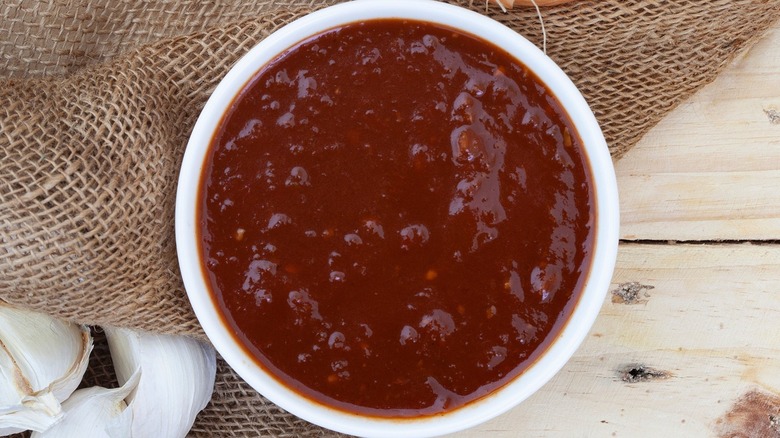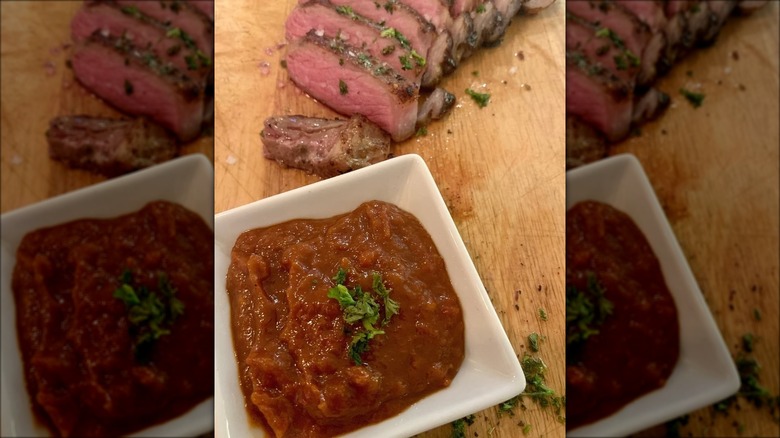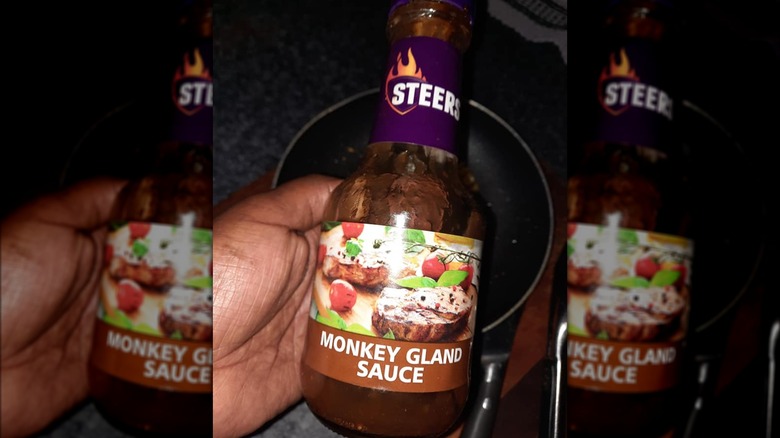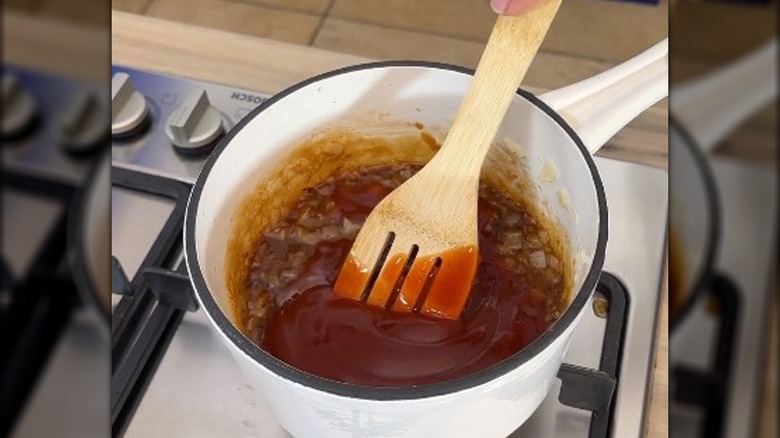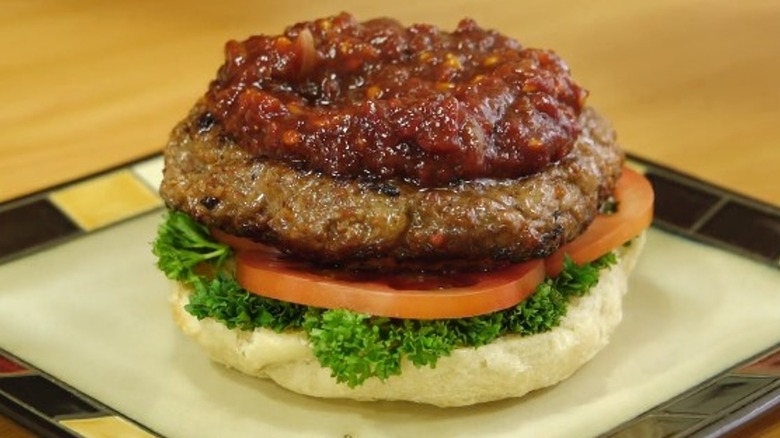Monkey Gland Sauce Isn't What You Think
Even if you aren't a trained, professional chef, it's usually fairly easy to determine what you'll be getting when ordering a meal. However, every so often, there comes a dish that isn't exactly what its name implies. Take sweetbreads, which, based on their name, sound like they could be a delicious baked good similar to beignets. In reality, the French delicacy is actually the thymus gland of a calf or lamb.
Rocky Mountain oysters are another example of culinary deception. They are only true to their moniker in that they are largely popular in the states that the massive mountain range runs through, namely, Colorado. The midwestern favorite isn't from the sea, and there isn't an ocean anywhere close to the Centennial State – though the fact that Rocky Mountain oysters are actually bull testicles might come as a surprise to the uninitiated.
Monkey gland sauce also falls into the category of foods that aren't what they say they are, and given what this condiment's name is, some may say that's for the best. So what, then, is monkey gland sauce? Whatever idea you have of it in your head, we can almost guarantee it isn't what you think ... unless you thought it was a combination of condiments that tastes like something you'd have at a barbecue.
What is monkey gland sauce?
Based on its name alone, monkey gland sauce may not be everybody's first choice when it comes to shaking up their condiment routine. However, just as we're taught not to judge a book by its cover, we shouldn't judge this sauce by its moniker, because it actually has nothing to do with animals or body parts.
In reality, it is a popular South African condiment back nearly 100 years ago to the 1930s. It combines other condiments you would commonly find in pantries across the rainbow nation like tomato sauce, chutney, and Worcestershire sauce, which come together with a few other ingredients to create a sweet and tangy condiment somewhat similar in look and taste to barbeque sauce. It is available at most restaurants and is a staple at South African braais, a.k.a. cookouts, and is usually used as a marinade, paired with steak or hamburgers, or used as a dipping sauce for things like onion rings and French fries.
There are a few stories behind the condiment's jarring name
Now that you know what monkey gland sauce is (and isn't), we're sure you're curious about its name. There are a few theories behind it, one of which involves Dr. Abrahamovitch Serge Voronoff, a French scientist from the late 1800s and early 1900s who was known for grafting tissue from monkey testicles onto men in an attempt to cure impotence. Apparently, Voronoff was a regular at the Savoy Hotel in London, where his typical meal of a brandied steak was given the nickname "monkey gland steak" by staff due to his experiments. Per Crush Magazine, one of the waiters from the hotel relocated to South Africa in the 1930s and brought the name with him, which was eventually bestowed upon the condiment.
A second theory once again places the origin of monkey gland sauce at a hotel, but this time at the Carlton Hotel in Johannesburg. The story goes that the French chefs were frustrated with patrons who covered their steaks with things like chutney, Worchestershire, or tomato sauce. In a sort of retaliation, the chefs decided to make their own condiment using those same ingredients that were, once again, named in honor of Dr. Voronoff. Meanwhile, a third story suggests that a Swiss chef created the sauce in the '60s when he had to throw together whatever he could find in the pantry to create a steak sauce on the fly (via Food 24).
Here's how to make your own monkey gland sauce
While you could certainly order a bottle of monkey gland sauce online, or perhaps even find some in the international foods aisle at your local grocery store, whipping this condiment up for yourself is actually fairly simple. As an added bonus, you've probably already got most of the ingredients for this condiment in your pantry and fridge. Score!
Recipes for monkey gland sauce can vary a bit, but many will call for some combination of the following ingredients: tomato sauce, Worcestershire sauce, chutney, onions, garlic cloves, fresh ginger, soy sauce, hot sauce, water, red wine vinegar, and salt and pepper. Some recipes will also include things like brown sugar, ketchup, or mustard. However, regardless of what is on the ingredient list, the cooking instructions are largely the same across the board.
To start, you're going to want to saute your diced onions, garlic, and ginger over medium heat. Once the onions have gotten translucent and soft, go ahead and add the remaining ingredients to the pot and cook everything together. Finally, allow your sauce to simmer and thicken, after which it will be ready to enjoy. So easy a monkey could do it, right?
What does monkey gland sauce taste like, and how do you use it?
Before going through all the trouble of making homemade monkey gland sauce, you may want to know what it tastes like and how to go about using it. As previously stated, the condiment is similar in taste to barbecue sauce in that it is both sweet and tangy. It has a slightly chunky texture and should have a slight kick. You may also be able to detect a hint of fruit due to the chutney.
There are a variety of ways you can use monkey gland sauce, too, starting with a dipping sauce for French fries or onion rings. My Golden Pear also suggests drizzling some on rice, pasta, potatoes, and even steamed veggies. However, the most common use for monkey gland sauce is with grilled meats such as steak, chicken, pork chops, and burgers, so if you have an end-of-summer cookout coming up, this condiment could be a unique addition to your spread. Perhaps you could even serve your monkey gland sauce-slathered burgers alongside a monkey gland cocktail. Similarly to the condiment, this adult bev also contains no traces of monkeys. However, it does call for a shot of absinthe, so you may want to drink with caution.
